Energy, as one of the world’s most valuable resources, provides an essential ingredient for all human activities and socio-economic development. In the near future, as the industrial sector dramatically expands, demand for energy will be even greater than it is today.
Compared with the traditional energy resources, solar energy is one of the most important areas for sustainable development. Among the different kinds of solar cells, dye-sensitized solar cells (DSSCs) are low cost, semi-transparent, easy to manufacture, and can utilize the indoor light resources for photovoltaic conversion. Zinc porphyrins (ZnPs) have attracted a lot of attention as efficient chromophores for DSSCs. The record for the power conversion efficiency of porphyrin-sensitized solar cells has been shown to reach 13% by improving the molecular design and solar cell materials, and recently, scientists have began to use ZnPs in bulk-heterojunction solar cells (BHJ SCs). 
In a recent article published in Solar-RRL, Ievgen Obraztsov, Wlodzimierz Kuner, and Francis D’Souza from Poland and USA, review the latest development of the molecular design of ZnPs for DSSCs, and demonstrate its influence on the design of small-molecule and polymer ZnP donors for BHJ SCs.
The authors briefly introduce the mechanisms of DSSCs and BHJ SCs respectively and identify the current challenges. For example, in DSSC, the lowest unoccupied molecular orbital (LUMO) energy level of the dye, the Fermi energy level of the transition-metal oxide (MO), and the redox potential of the charge mediator could limit the maximum open-circuit voltage; while the dye concentration on the MO surface, the efficiency of the light absorbance of the dye, etc. could limit the maximum short-circuit photo-current. Moreover, the scientists discuss in detail how the functional design of the porphyrin benefits these two types of solar energy in the following processes: 1) the design of porphyrin molecule and 2) the functional design of porphyrin peripheral meso-substituents. Finally, the authors discuss the prospective research directions for the optimization of DSSC construction as well as dye and electrolyte, and for tailoring the molecular design of the donor, the buffer layers, and the cell construction in BHJ SCs.
As the field of DSSCs and BHI SCs continues to grow, the extensive overview of the mechanism studies of DSSCs and BHI SCs given in the current review could not have arrived at a better time.
This article was kindly provided by Dr. Pei Dong of Rice University, Houston, Texas , and edited by Ekaterina Perets.

















